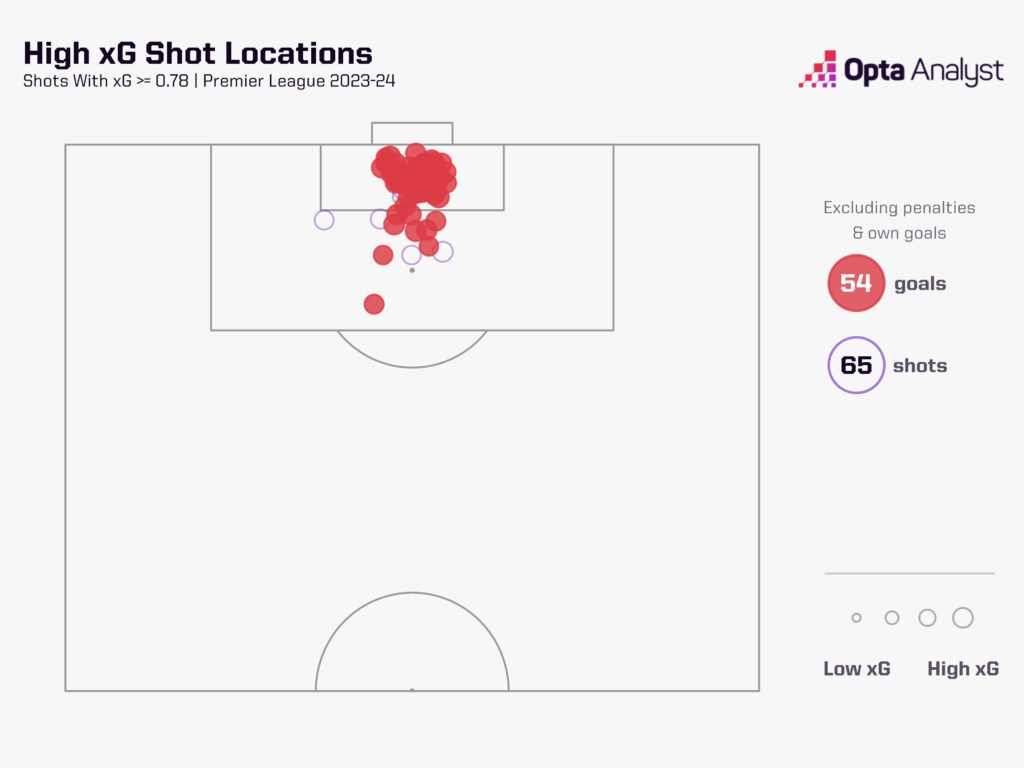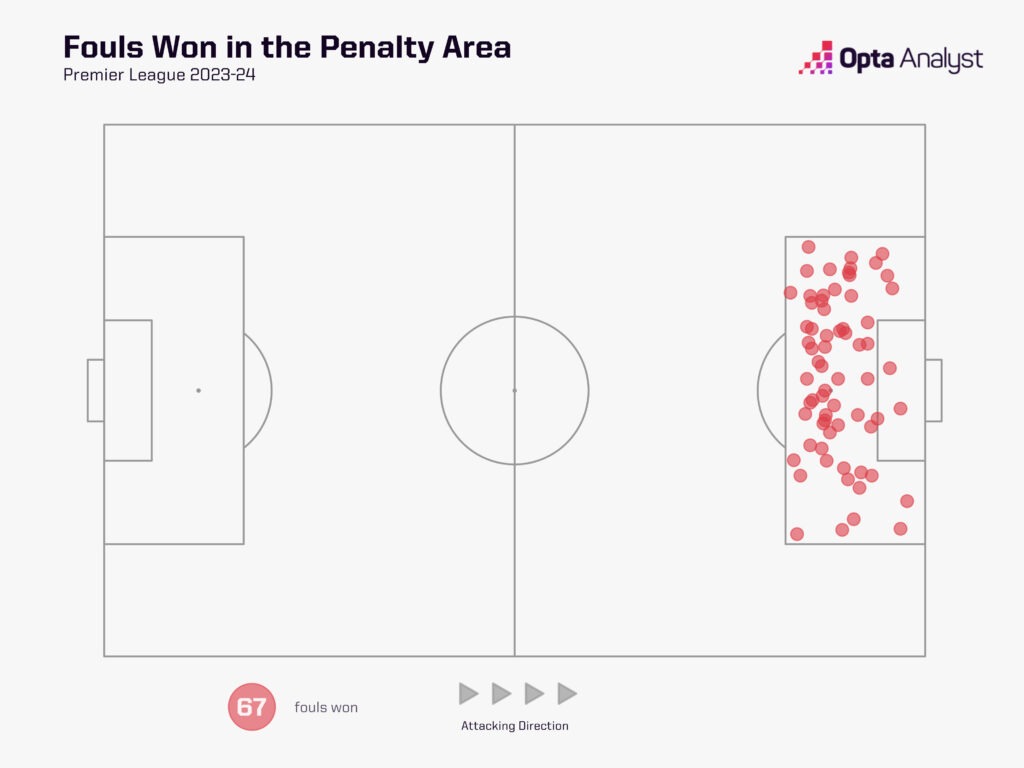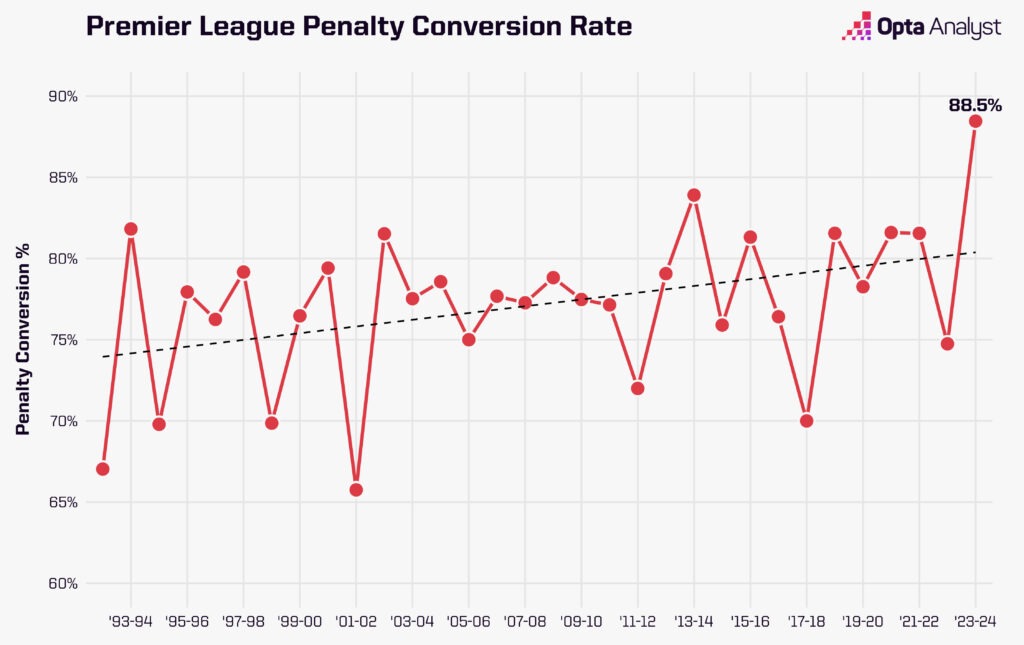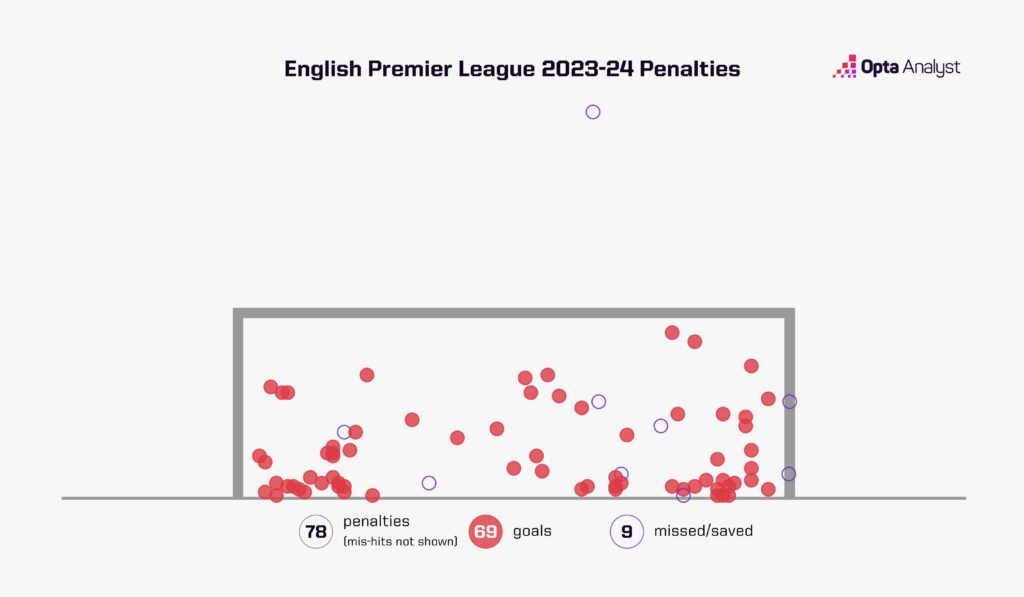The conversion of Premier League penalties is at an all-time high this season, making them more important than ever.
Penalties; they’re either scored, or they’re not. On the scoreboard, there’s not much more to them, but that doesn’t mean they’re boring to analyse. In fact, the opposite is true because they’re such isolated events and bound by relative simplicity.
They are unique in football. No other event or situation in the sport is as regimented, so in many ways they’re perfect for statistical analysis. Think of them like a lab experiment, with the control variables (laws of the game) remaining constant (well, sort of…) to ensure consistency or accuracy in results that are ripe for comparison.
For instance, the location of the spot-kick is always the same, the goalkeeper must always be on their line when the penalty is taken (more on that later), the size of the goal is unchanged and the minimum proximity of teammates or opponents to the ball is constant.
And yet, no two penalties are the same and just because one player/goalkeeper is good at scoring/saving them doesn’t mean the next is. Similarly, being impressive from the spot or having a good record of saving penalties is not necessarily a marker of being an outstanding outfield player/goalkeeper, but both are skills that can be decisive.
Last weekend was a notable one for penalties in the English top flight. Alejandro Garnacho became the first Manchester United player in Premier League history to win two in a single game, and Dominic Solanke’s sliced effort over the crossbar was the first spot-kick this season to completely miss the goal and the goal frame.
The latter should then be seen as an indicator of how good penalties have generally been in the Premier League this term.
Alexis Mac Allister’s spot-kick slammed just beyond the reach of Ederson’s dive in Sunday’s thrilling 1-1 draw between Liverpool and Manchester City at Anfield saw him enter the list of the Premier League’s best penalty takers. It was also the 78th of the 2023-24 season.
That means the competition is on track for over 100 penalties this term, with the per-game average set at 0.28. That in itself isn’t especially unusual because eight previous Premier League seasons have seen 100+ penalties, but only three have had a greater per-game average; 2020-21 holds the record for both with a total of 125 at a rate of one every three games (0.33).
Penalties are a hugely prominent part of the game even if we potentially subconsciously perceive them to be rare in the context of other match events; after all, they were once much rarer than they are now, and their increased prevalence makes penalties an even more valuable aspect of the game to master, whether kicker or keeper.
The expected goals (xG) value of every penalty is 0.78 because about 78% of them are scored on average. Now, in the analytics community that fact is common knowledge, whereas to wider football fandom it might not be and may even seem a little low.
But, generally speaking, 0.78 xG is extremely high, as we can prove by looking at all shots in the Premier League this season. Excluding penalties and own goals, only 65 attempts have been worth 0.78 xG or more out of a possible 7,193; that’s just 0.9%.

Another way of putting that in context is to look at the number of penalties scored in relation to all goals; that’s 7.7% this season and has never been lower than 4.8% (2001-02) over a full Premier League campaign.
So, it’s no wonder there’s an established school of thought that the punishment of conceding a penalty vastly outweighs the significance of the penalised offence in general, and this season the concession of a spot-kick is proving more costly than ever before.

A penalty is scored every four games (0.25 per game) on average in 2023-24, which is the second-highest frequency ever in the Premier League; however, penalty conversion rates have never been higher, with 88.5% of those awarded this term resulting in a goal.
The previous best proportion of penalties scored in a single Premier League campaign was 83.9% in 2013-14, and this season’s figure is a considerable increase from the 74.8% converted in 2022-23, which was the seventh-lowest in the top flight since 1992.
Although this might suggest a degree of randomness in the rate at which penalties are scored between seasons, the general trend we can see in the data is that failing to convert spot-kicks is more unusual now.

Over the four seasons (including 2023-24) since the start of 2020-21, 81.6% of penalties have resulted in goals; that’s the highest proportion over a four-season period in Premier League history, with only one other (2016-17 to 2019-20) getting above 80% (80.1%), and it’d obviously be even higher were it not for the aforementioned dip in 2022-23.
The lowest figure over a four-year spell was 74.2% across the first four Premier League seasons.
Of course, the flipside to a greater proportion of penalties being scored is that fewer are being saved, with Alphonse Areola (two) the only goalkeeper to keep out more than one in 2023-24.
Just six of the 78 taken this term have been saved, which is a mere 7.7%; if it remains at that level or similar for the rest of the campaign, then it’ll be the season with the lowest proportion of saved penalties, ahead of 1997-98 (9.7%). Only seven were kept out back then, though the total number of spot-kicks (72) was lower.

It wasn’t too long ago that goalkeepers collectively had their best-ever Premier League season for stopping penalties. In 2017-18, over a quarter of all penalties (26.3% – 21/80) were saved; that figure had never been higher before, and we may never see a repeat of it.
That’s partly because ahead of the 2019-20 season, the International Football Association Board (IFAB) announced a change that required goalkeepers to have at least a part of one foot on the goalline when a penalty is taken, and this coincided with the introduction of VAR, limiting keepers’ chances of getting away with any potential indiscretions. While we can’t say this is the sole cause, it’s difficult to believe saves becoming more infrequent isn’t a knock-on effect.
Over the four seasons going back to the start of 2020-21, 11.7% of penalties have been saved on average per season. That’s down from 19.1% over the previous four-year period, and comfortably the lowest ever over a four-season spell in the Premier League.
In 2017-18, five goalkeepers saved two or more penalties, with Lukasz Fabianski keeping three out; since then, no more than three goalkeepers have made two or more penalty saves in a single season.
Of course, some rule tweaking and the arrival of VAR over four years ago aren’t the only theories put forward to explain this season’s spike in penalty conversion.
Earlier this season, The Athletic put it down to an increase in penalties taken by left-footers. It’s a fact that there’s been a greater proportion of penalties taken by left-footed players this term than in any previous Premier League campaign, with that figure at 39.7% ahead of this weekend.
It also cannot be denied that there’s been a gradual increase in total left-footed penalties since the aforementioned changes in 2019-20 when there were just seven taken by lefties; the 31 in 2023-24 is already a record and there are still 101 matches to be played, with five of the nine players to have scored at least three penalties this season preferring their left foot, including Cole Palmer, Mohamed Salah and Erling Haaland.
It’s an entirely plausible theory that the significant increase in left-footed takers combined with the law changes in 2019-20 is partly behind the general improvement because historically they have taken fewer than right-footers, meaning goalkeepers are more used to the behaviours of right-footed players in such scenarios.
But, in reality, there probably isn’t one specific answer or reason. After all, left-footers did take penalties before 2019-20, and rarely did it obviously correlate with abnormal conversion rates. The fact players are getting very positive results from placing penalties straight down the middle is potentially another piece of the puzzle.
For takers, though, penalties are as much about psychology as they are technical ability because the fact is no amount of training can help you replicate the in-game scenario that sees you standing at the spot in front of thousands of screaming spectators.
It’s also fair to suggest the standard of the average Premier League player is better than ever, and while there has been a dramatic improvement in effectiveness from the spot this term, it’s still in keeping with a general upward trend in this respect over the past few years.
Similarly, perhaps this season the Premier League just happens to have more players with the kind of unflappable mentality that helps make a fine penalty taker, or maybe goalkeepers are just getting unlucky.
All we can say for certain at the moment is, penalties are more valuable than ever because never before have they been closer to a free goal.
Enjoy this? Subscribe to our football newsletter to receive exclusive weekly content. You should also follow our social accounts over on X, Instagram, TikTok and Facebook.
